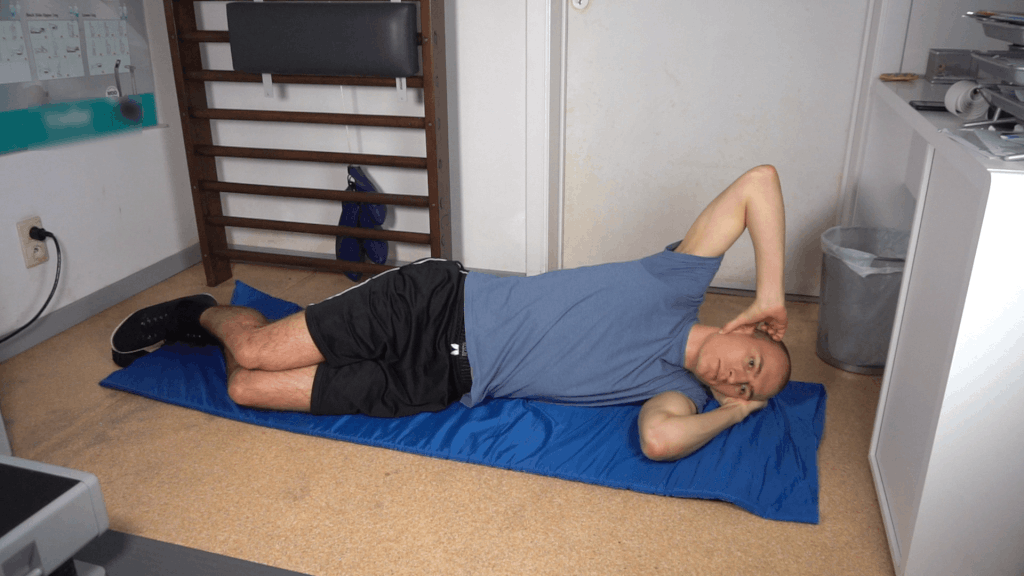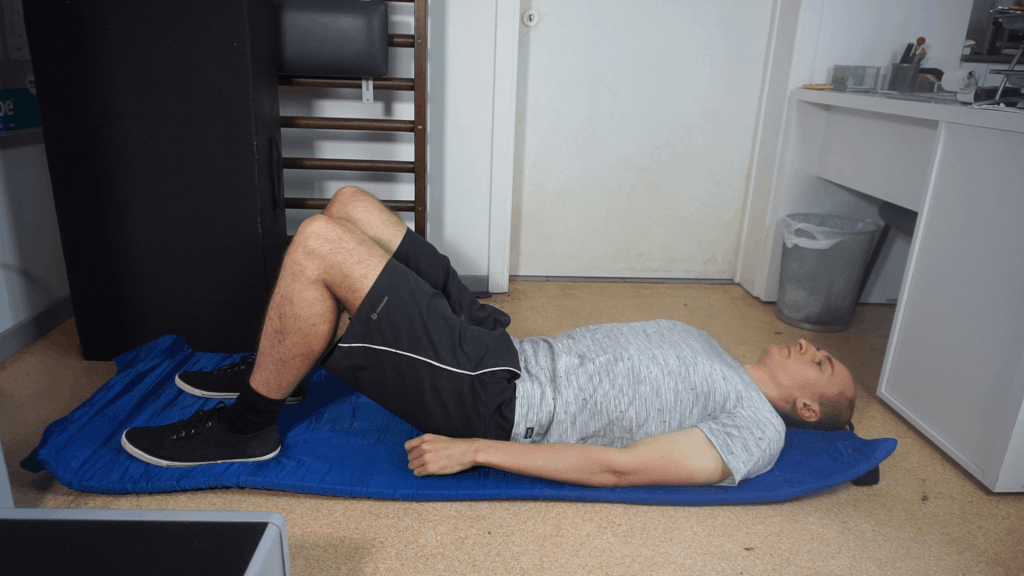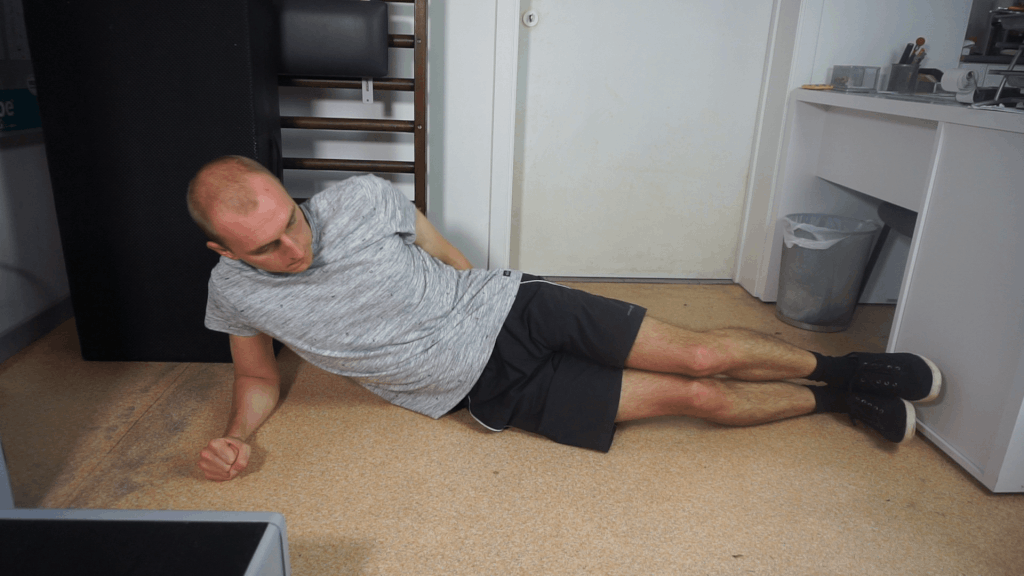Side bends can offer valuable benefits but they are not for everyone. Discover some alternative exercises with similar effects.
In side bends, you tilt your upper body to one side and back, usually while holding some weight.
The main goal of doing this is to grow and strengthen the oblique muscles in your sides that are responsible for this movement. You also get some of the other typical positive effects of resistance training.
Whether you don’t enjoy side bends, they feel uncomfortable on your back, or you want an alternative for any other reason, these other options could be a better choice for your workout program.
1. Side crunches
In essence, you don’t need any equipment for the first side bend alternative. In practice, something like a yoga mat or another soft surface can make side crunches a lot more comfortable.
Take the following steps to do the exercise:
- Lie down sideways. You can fold your legs for stability and put one arm below your head for comfort. You can keep the upper arm against your body.
- Slowly raise your shoulders from the ground as much as comfortably possible while keeping your hips on the floor. Move your head along with your shoulders while keeping your neck in a straight position.
- Lower your shoulders and head in a controlled motion until you are back in the starting position.
- Repeat the same number of repetitions on the other side.

Side crunches are basically the same movement as side bends but you are lying down on your side. This makes them a good substitute if you don’t like the standing aspect but still want to work the same oblique muscles.
Because of the different angle, the bodyweight version of side crunches is more challenging than bodyweight side bands. This can be a big benefit for stronger individuals who don’t have a lot of extra weights available.
A downside of side crunches is that the range of motion of your core muscles is smaller. This is less optimal for muscle growth and strength progress.
2. Hanging sideways knee raises
For hanging core exercises like sideways knee raises you need a captain’s chair, a pull-up bar, or another similar setup where your legs hang freely.
Take the following steps to do a sideways knee raise on a pull-up bar:
- Hang from the pull-up bar with your hands at about shoulder-width with your hand palms facing forward. Let your legs hang down for now.
- Raise your knees held together to about hip height. Let gravity do its work on your lower legs throughout the exercise.
- Raise one hip as far as comfortable
- Repeat the same number of hip raises on the other side.
Hanging sideways knee raises are another good alternative to side bends in the sense that they work similar oblique muscles.
If the bodyweight knee raise version is too easy for you, you can either keep your legs stretched or do the exercise with extra resistance.
Ankle weights are great since they can’t fall down but you could also clamp a weight like a dumbbell between your legs.
Similar to side crunches, one downside of hanging sideways knee raises is that your oblique muscles go through a slightly smaller range of motion compared to side bends.
3. Heel taps
Heel taps are another side bend alternative where you benefit from a soft surface to lie down on. Take the following steps to do the exercise:
- Lie down on your back with your feet on the ground. Your arms are stretched and by your sides.
- Raise your shoulders and push your lower back against the ground with the help of your ab muscles. Keep your neck in line with your upper body.
- Slightly turn your upper body to one side and reach with your hand toward the heel of the foot on this side. You can actually tap it as the exercise name implies but the important part is turning your body far enough.
- Return to the position in step 2. Try to keep your shoulders off the ground during the exercise.
- Repeat step 3 but by tilting your body to the other side.
- Keep tapping each heel alternately.

The name of the exercise implies differently but you don’t have to stop at your heels if you can go further in a comfortable way.
Heel taps do still engage the same muscles as side bends a nice amount but the focus is more on your ab muscles. These have to work throughout the movement to keep your shoulders off the ground.
Whether this different muscle engagement is a benefit or downside depends on your training goals.
In any case, you can hold weights against your chest while still moving your upper body in the same way to make the movement more challenging.
4. Suitcase carry
You can describe the suitcase carry as walking in the starting position of side bends. You simply pick up some type of one-handed weight and walk a certain distance or time. This works more muscles.
First of all, you still work the same muscles as the side bend but in an isometric, static, way to keep your body upright.
Additionally, your other core muscles will have to work to keep your upper body upright. Your leg muscles will have to work to step forward. And a few shoulder stabilization muscles will work to keep your arm in position.
Besides the different muscle engagement, suitcase carries also work these body parts in a different way. This alternative focuses more on muscle endurance which is different from side bends which tend to focus on strength.
These things can be good or bad depending on your training goals. The suitcase carry is definitely more of a functional compound exercise.
The suitcase carry could also be more comfortable on your back since you keep your spine neutral. Besides that, you will burn more calories than side bends which can help with controlling your weight.
5. Side plank hip dips
Side plank hip dips can be done with just your body weight but something soft below your arms can improve comfort. Take the following steps to do the exercise:
- Sit sideways on the ground leaning on one of your lower arms with the upper arm of that arm vertical to support your upper body.
- Walk away from your upper body with your feet until you can put your body in a straight side plank.
- Move your hips as far down as comfortable.
- Move your hips as far up as comfortable.
- Return your body into the position of step 2 in a controlled motion.
- Repeat the same number of repetitions while leaning on your other arm.

Side plank hip dips are another alternative that focuses on more muscles than side bends.
On top of your obliques, you also work your hip abductors (outer thigh muscles) a nice amount and your abs and lower back to some extent.
This exercise allows your oblique muscles to go through a nice range of motion under tension without bending your spine that much to either side. Some people may find this more comfortable than side bends.
Something to note is that individuals who are somewhat experienced with core training likely need extra resistance to make side plank hip dips challenging enough.
You can do this by holding something like a dumbbell on your hips with your free hand.
6. Landmine rotations
For the next alternative to side bends you need a landmine setup. This is an attachment that secures a barbell at the ground level on one side.
The landmine setup opens the door to exercises like landmine rotations. Take the following steps to do this exercise:
- Set up the landmine with the desired number of weight plates.
- Get the sleeve (end of the barbell) above your head with your hands on it, stand with your feet slightly narrower than shoulder width, arms slightly less than stretched, and lean somewhat forward.
- Slowly lower your hands that are holding the barbell sideways to about hip height. Rotate your hips a small amount in the same direction. Keep your arms slightly less than stretched throughout the rest of the exercise.
- Elevate the barbell in a similar motion to the position of step 2.
- Repeat the same movement but in the other direction.
Landmine rotations engage both the oblique muscles responsible for bending to the sides and rotating your upper body a nice amount.
Additionally, your ab and lower back muscles will have to work to some extent to keep your upper body upright.
This exercise can be great for individuals who want a more all-around core exercise and people who simply want to change up their core training. It also becomes easier to challenge your core with a lot of weight.
One potential downside of landmine rotations is that the equipment requirements are more strict. If you work out at home and don’t have the equipment already, this could be a pricey alternative.
Additionally, landmine rotations work your shoulder and upper back muscles more. Some people may not like this.
7. Ab wheel V-rolls
The ab wheel is a small and inexpensive piece of fitness equipment that is a wheel with two handles. It may not look like much but you can use them instead of other core exercises like side bends.
Take the following steps to do an ab wheel knee V-roll:
- Start with your face facing the floor on your knees and with your hands on the ab wheel.
- Stretch your hips so that your body is in a straight line from your knees to your shoulders.
- Roll forward and to one side in a controlled motion, preferably until your stomach is right above the ground.
- Slowly roll back into the position of step 2.
- Roll forward and to the opposite side as step 3 in a controlled motion.
If you do this exercise right the ab wheel should draw an imaginary V-shape on the ground.
The specific V-roll exercise focuses more on your oblique muscles than a regular roll-out. In turn, this makes it a somewhat better alternative to side bends.
At the same time, you need to keep in mind that ab wheel V-rolls focus more on the oblique muscles that rotate your upper body instead of the oblique muscles that bend your upper body similar to side bends.
Your ab muscles will also have to work a lot harder.
Focusing on these different core muscles is not necessarily better or worse for everyone but many people do find ab wheel V-rolls more comfortable on their back and more interesting.
